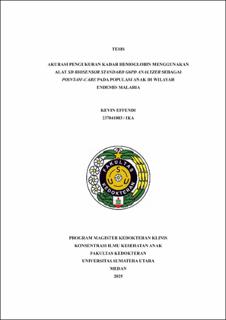Akurasi Pengukuran Kadar Hemoglobin Menggunakan Alat SD Biosensor Standard G6PD Analyzer sebagai Point-Of-Care pada Populasi Anak di Wilayah Endemis Malaria
Accuracy of Hemoglobin Level Measurement Using SD Biosensor Standard G6PD Analyzer as Point-Of-Care in Pediatric Population in Malaria-Endemic Area

Date
2025Author
Effendi, Kevin
Advisor(s)
Pasaribu, Ayodhia Pitaloka
Siregar, Rosmayanti Syafriani
Metadata
Show full item recordAbstract
Background: Malaria remains a significant public health concern, particularly in
endemic regions, is frequently associated with anemia in children. Accurate
hemoglobin measurement is crucial for diagnosing anemia, especially in resourcelimited
settings. This study compares the accuracy of SD Biosensor Standard G6PD
Analyzer with Hemocue HB301 System for hemoglobin measurement among
children in malaria-endemic areas.
Objective: To determine the sensitivity, specificity, positive predictive value
(PPV), negative predictive value (NPV), positive likelihood ratio (LR+), negative
likelihood ratio (LR-), pretest odds, post-test odds, and overall accuracy of the SD
Biosensor Standard G6PD Analyzer compared to the Hemocue HB301 System.
Method: This cross-sectional diagnostic study involved 325 children aged 6-18
years in Kualuh Leidong District. Secondary data were obtained from a previous
study conducted in August 2024, using a total sampling technique.
Result: The mean hemoglobin level measured by SD Biosensor Standard G6PD
Analyzer (14,22±2,21 mg/dL) was higher than that measured by Hemocue HB301
System (13,45±1,63 mg/dL), with significant difference (p=0,001). The prevalence
of anemia detected by SD Biosensor and Hemocue was 12,3% and 11,4%,
respectively. The SD Biosensor Standard G6PD Analyzer demonstrated a
sensitivity of 70,27%, specificity of 95,14%, PPV of 65%, NPV of 96,14% and an
overall accuracy of 92,31%.
Conclusion: The SD Biosensor Standard G6PD Analyzer exhibited relatively low
sensitivity but high specificity compared to Hemocue HB301 System in measuring
hemoglobin levels among children in malaria-endemic areas. Further research is
needed to compare both devices against the gold-standard automated hematology
analyzer and to identify the factors influencing measurement accuracy.
